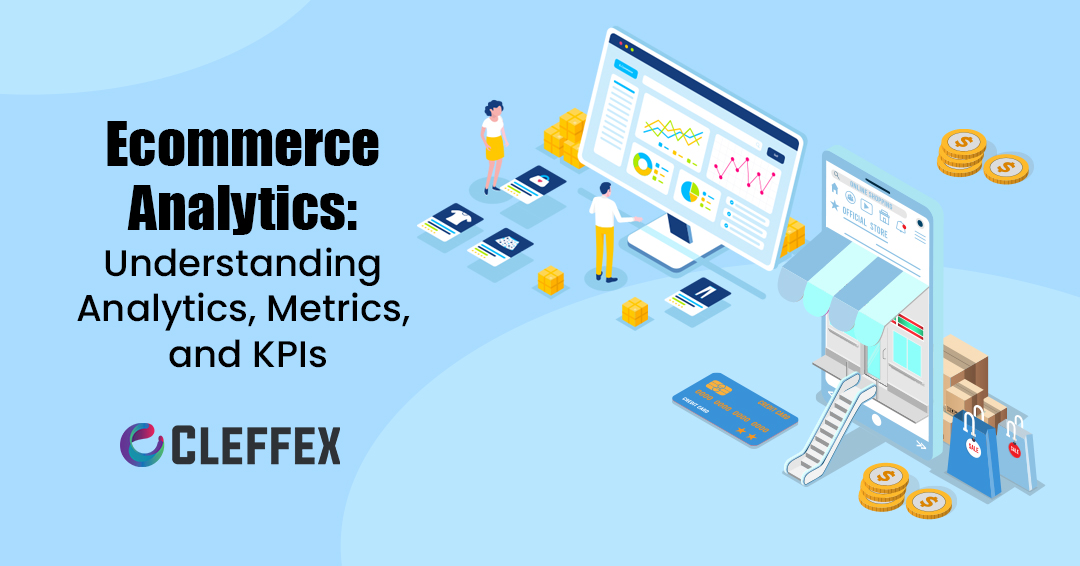Metrics and KPIs are an integral part of ecommerce analytics. They provide valuable insights into the performance of an ecommerce business and help in making data-driven decisions to improve the overall customer experience and increase profitability.
Analytics serve as the eyes and ears of a contemporary business, enabling us to comprehend the internal and external operations of the organization and make informed choices. In this blog post, we’ll delve into how analytics can be used to monitor and enhance the performance of an ecommerce business, and explore techniques for recognizing crucial metrics.
What are Metrics in Ecommerce Analytics?
Before moving forward, let’s establish some definitions. Analytics refers to the collection and analysis of information, and is typically used in a plural form. The individual measurements obtained in the process of analytics are referred to as metrics. Metrics provide quantitative information to answer specific questions, such as temperature to determine the level of heat or pressure to determine tire inflation. In short, metrics are simple pieces of information that can be easily understood.
What are KPIs in Ecommerce Analytics?
The term KPI, or Key Performance Indicator, is commonly used in business meetings. KPIs are just a small group of metrics that give insight into an organization’s progress in achieving its vital goals. The total employee count may be of interest as a metric to understand the growth rate and answer some crucial legal questions but having 100 employees by 2023 is not likely a business objective. Thus, employee count is usually not considered a KPI. However, the employee count can be used to calculate another metric, such as profit or revenue per employee, which shows the efficiency of a business and allows comparisons to be made across businesses in the same or different industries. If improving efficiency is a priority, tracking profit per employee may be a desirable KPI.
It’s crucial to consider metrics in the right context, which will be discussed below. Here, the term “metric” will be used instead of KPI, as it is more comprehensive. However, it’s important to keep in mind that any metric could become a KPI, based on what is essential for your business at a given time.
Why are Metrics Important in Ecommerce Analytics?
Let us discuss the importance of tracking ecommerce analytics metrics. Suppose you wanted to determine customer satisfaction levels. You could try a qualitative approach, such as asking your sales team for their opinions, or reading customer reviews on platforms like Google or Yelp or similar platforms. These methods may provide some valuable insights and anecdotes, but it’s difficult to make confident decisions based on them, and it’s also challenging to track improvement over time when new data becomes available each month.
One effective way to assess customer satisfaction is by tracking ecommerce analytics metrics, which are numerical measurements of customer satisfaction. For example, in regards to online reviews, this is typically represented by a rating system, such as a 5-star scale. A significant number of customers trust this method, as it has been estimated that 70% of new customers choose businesses based on their ratings, with the most common filter being businesses with a rating of 4 stars or higher. The reason for this is that the average rating provides a quick and reliable understanding of a business’s quality, allowing customers to save time and have confidence in their choice.
Tracking the average customer review rating over time is a good way to measure changes in customer satisfaction. Other metrics, such as the percentage of low-star reviews, can also be important in determining customer satisfaction. The average rating can be helpful for customers to see, but companies often use the Net Promoter Score (NPS) as an internal measurement of customer satisfaction. Using metrics such as the average rating or NPS makes it easier to interpret and set goals for customer satisfaction compared to relying on updates from sales teams or individual reviews.
It is possible to transform qualitative information from review content into quantitative ecommerce analytics metrics through techniques such as text classification and sentiment analysis, although these can be more difficult to put into practice.
Which Metrics are Important for Your Business According to Ecommerce Analytics?
Determining the right metrics to track for your business can be challenging, but there are steps you can take to identify the right metrics in ecommerce analytics. First, make sure you have a clear understanding of your business goals. This might have been established when the business was first founded, but it’s worth revisiting to ensure the goals are still relevant. Then, assess your current situation by answering questions such as who your customers are, how much you are selling, and your profitability and brand perception. If there is a question without a clear answer, consider tracking a related metric to get more insight. Finally, once you know where you are and where you want to go, create a roadmap for how you’ll get there. Tools like SWOT, PESTLE, and 5 Forces analysis can help with this diagnostic and planning process.
Your roadmap will often have a set of ecommerce analytics metrics related to it that will allow you to monitor your progress as you work towards your goals. If your aim is to increase sales, you may track metrics like the number of qualified leads, conversion rate, or average order value. To diversify your revenue streams, tracking sales by product category or market segment may be helpful. To gauge customer satisfaction, metrics like Net Promoter Score, customer retention rate, and return/exchange rate may be more relevant.
It may be tempting to track as much data as possible, but it is important to keep in mind that tracking too many metrics can lead to information overload and can make it difficult to review, interpret, and make decisions based on the data. Instead, focus on tracking the most important ecommerce analytics metrics that align with your business goals, and avoid creating a lengthy report of numerous metrics that you are unlikely to review and use effectively.
Be Cautious of Vanity Metrics
Beware of metrics that appear to be impressive but do not provide meaningful information, known as vanity metrics. These metrics are often used to make a business look good, but they do not give you any real information. Examples of vanity metrics include the total number of social media followers, ad impressions, page views, total all-time sales, and all-time customer count. However, these metrics may not be relevant or important for your business, even if other businesses are tracking them.
It’s important to understand that metrics traditionally considered “vanity metrics” may still have value for your business. For instance, if you’re looking to create awareness about a new brand, ad impressions may actually be important to you, even though they are typically considered a vanity metric. In this scenario, you might use ads to expose potential customers to your brand multiple times before expecting a sale, in which case tracking impressions could help you gauge the success of your marketing efforts.
To determine the value of a metric, ask yourself if a change in the metric would prompt you to take action and if that action would have a significant impact on your business. The most valuable metrics are those for which the answer to both these questions is affirmative.
What are the Targets That You Should Set for Your Metrics?
It’s recommended to establish targets once you have decided on your key metrics. You can use the SMART goal technique, which ensures your goals are specific, measurable, relevant, and time-bound. Your chosen metrics should already be specific and measurable, and relevant to your business. When it comes to your target values, make sure they are relevant and make sense for your business to pursue. For example, if you are tracking the cart abandonment rate and it’s already far below the industry average, it may not make sense to invest time and resources to lower it further, but rather keep an eye on it for now and focus on other areas that require more attention.
In setting targets for your key metrics, it’s crucial to ensure that they are achievable. Having goals that are too difficult to reach can affect the motivation of you and your team. While having a long-term vision is encouraged, it’s better to start with short-term targets that are realistic and achievable. This way, you and your team can get some positive results and build momentum as you continue to develop your analytics initiatives.
Effective use of metrics and ecommerce analytics is crucial for online retailers to understand their customers’ behaviour and make informed decisions to improve their bottom line.
The Context Must be Considered
The context in which metrics are viewed is crucial in both planning and evaluating them. One metric should be looked at in relation to other metrics to gain a complete understanding. For example, a surge in product sales may seem great, but if there is also a high return rate or if the product had to be heavily discounted, then those sales may not be as valuable as they seem. To get a more informative view, metrics can be combined through the use of dashboards or calculated metrics. Both of these methods will be explored further in the section
When reviewing your key metrics, it’s important to consider them not just at a single point in time but in relation to where you’ve been and where you’re going. This requires looking at the trend of the metrics over the past 3-6 months, not just a monthly snapshot. It’s also helpful to show the target on the visual representation of the data so it’s clear how far you have to go. Ask yourself questions such as how far you are from the target, if there has been improvement compared to last month, and how many months in a row there have been improvements. This will help you understand not only the current state but also the trajectory of your metrics.
The final point on context is the importance of industry benchmarks. These are metrics that are commonly tracked across various businesses and can provide insight into what reasonable targets might be. For example, the average profit per employee in apparel is $26,000, and the average cart abandonment rate in online retail is 73%. However, these benchmarks should be used with caution. If you are still growing your business, what other established businesses are doing may not be relevant to you. Additionally, differences in products, regions, and other factors make business-to-business comparisons difficult. Focus on your own progress, that is the most important thing. Have you improved your metrics, are you moving towards your important targets, and is your business profitable while bringing satisfaction to your customers, employees, and yourself? Keep these external benchmarks in mind, but don’t put too much pressure on yourself to match them.
Final Thoughts
We hope that by now you have gained a solid understanding of the significance of metrics for your business, how to align them with your objectives, and how to analyse the results once you begin tracking them. If you are looking for an efficient software development company with excellent digital marketing services and ecommerce development services, reach out to Cleffex ! We are here to help you!









